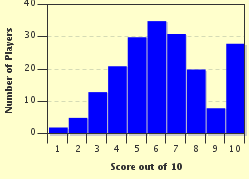Quiz Answer Key and Fun Facts
1. At the start of the lesson, you traditionally mount from the right side of the horse.
2. Your instructor asks you to start the ride on the right rein. What does this mean?
3. Your instructor asks you to squeeze with your lower legs. What does this do?
4. 'Sitting trot' is one type of trot a rider can do. What is the other?
5. When doing rising trot, how do you change your diagonal?
6. Which is your horse's correct leading leg in canter?
7. What is it called when your horse has energy but not speed?
8. What does it mean when your horse is disunited?
9. What is a rein-back?
10. At the end of the lesson, you need to cool your horse off until it has recovered from the exercise. What should a relaxed horse's breathing rate be?
Source: Author
pugzzzz
This quiz was reviewed by FunTrivia editor
Tizzabelle before going online.
Any errors found in FunTrivia content are routinely corrected through our feedback system.

